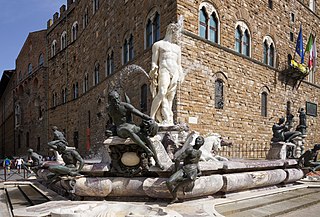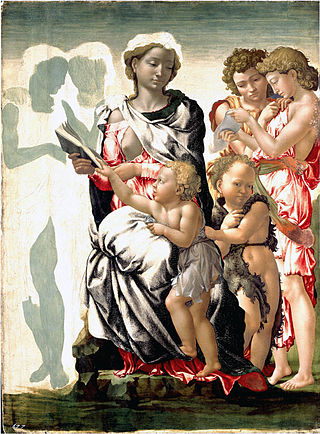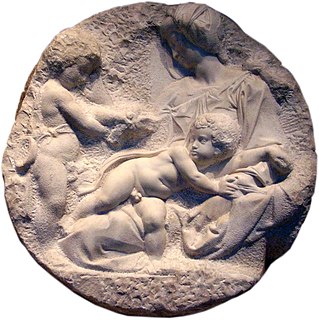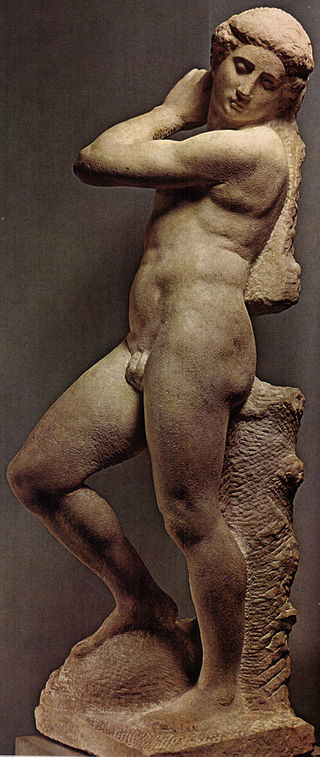
Bartolomeo Ammannati was an Italian architect and sculptor, born at Settignano, near Florence, Italy. He studied under Baccio Bandinelli and Jacopo Sansovino and closely imitated the style of Michelangelo.

Desiderio da Settignano, real name Desiderio de Bartolomeo di Francesco detto Ferro was an Italian Renaissance sculptor active in north Italy.

The Pietà is a subject in Christian art depicting the Blessed Virgin Mary cradling the mortal body of Jesus Christ after his Descent from the Cross. It is most often found in sculpture. The Pietà is a specific form of the Lamentation of Christ in which Jesus is mourned by sole privilege of the Virgin Mary alone, whilst representing her "sixth sorrow" and sometimes accompanied by a specific Marian title.

The Bargello, also known as the Palazzo del Bargello or Palazzo del Popolo, is a former barracks and prison in Florence, Italy. Since 1865, it has housed the Museo Nazionale del Bargello, a national art museum.

The Madonna of the Stairs is a relief sculpture by Michelangelo in the Casa Buonarroti, Florence. It was sculpted around 1490, when Michelangelo was about fifteen. This and the Battle of the Centaurs were Michelangelo's first two sculptures. The first reference to the Madonna of the Stairs as a work by Michelangelo was in the 1568 edition of Giorgio Vasari's Lives of the Most Excellent Painters, Sculptors, and Architects.

Aristodemo Costoli (1803–1871) was an Italian sculptor who spent his entire career in the city of Florence. He is also known for attempting in 1843 to clean and conserve the famed Renaissance-era sculpture David by Michelangelo; unfortunately his hydrochloric acid cleaning solution removed the stone's waxy protective coating and left the surface pitted and porous. His students included Emilio Zocchi, Girolamo Masini, Augusto Rivalta and his son Leopoldo Costoli.

The Doni Tondo or Doni Madonna, is the only finished panel painting by the mature Michelangelo to survive. Now in the Uffizi in Florence, Italy, and still in its original frame, the Doni Tondo was probably commissioned by Agnolo Doni to commemorate his marriage to Maddalena Strozzi, the daughter of a powerful Tuscan family. The painting is in the form of a tondo, meaning in Italian, 'round', a shape which is frequently associated during the Renaissance with domestic ideas.

The Alba Madonna is a tondo (circular) oil on wood transferred to canvas painting by the Italian High Renaissance artist Raphael, created c. 1511, depicting Mary, Jesus, and John the Baptist in a typical Italian countryside.

The Entombment is an unfinished oil-on-panel painting of the burial of Jesus, now generally attributed to the Italian Renaissance master Michelangelo Buonarroti and dated to around 1500 or 1501. It is in the National Gallery in London, which purchased the work in 1868 from Robert Macpherson, a Scottish photographer resident in Rome, who, according to various conflicting accounts, had acquired the painting there some 20 years earlier. It is one of a handful of paintings attributed to Michelangelo, alongside the Manchester Madonna, the Doni Tondo, and possibly, The Torment of Saint Anthony.

The Madonna and Child with St John and Angels (c. 1497), also known as The Manchester Madonna, is an unfinished painting in the National Gallery, London, attributed to Michelangelo. It is one of three surviving panel paintings attributed to the artist and has been dated to his first period in Rome. The work first came to public attention in the Art Treasures Exhibition in Manchester in 1857, hence the title the "Manchester Madonna". Attribution of the painting to Michelangelo was in doubt for much of the nineteenth and twentieth centuries, but now most scholars are in agreement.

Bastiano di Bartolo Mainardi (1466–1513) was an Italian painter of the Early Renaissance. He was born in San Gimignano and was active there and in Florence.

The Virgin and Child with the Infant Saint John the Baptist is a tempera painting on wood executed by the Italian Renaissance master Sandro Botticelli and his studio. The tondo, painted in Florence between the years of 1490 and 1500, addresses a central theme of the Italian Renaissance art: the divine motherhood. The work is now in the São Paulo Museum of Art.

Andrea del Sarto was an Italian painter from Florence, whose career flourished during the High Renaissance and early Mannerism. He was known as an outstanding fresco decorator, painter of altar-pieces, portraitist, draughtsman, and colorist. Although highly regarded during his lifetime as an artist senza errori, his renown was eclipsed after his death by that of his contemporaries Leonardo da Vinci, Michelangelo, and Raphael.

The Taddei Tondo or The Virgin and Child with the Infant St. John is an unfinished marble relief tondo of the Madonna and Child and the infant Saint John the Baptist, by the Italian Renaissance artist Michelangelo Buonarroti. It is in the permanent collection of the Royal Academy of Arts in London. The tondo is the only marble sculpture by Michelangelo in Great Britain. A "perfect demonstration" of his carving technique, the work delivers a "powerful emotional and narrative punch".

The Medici Madonna is a marble sculpture carved by the Italian Renaissance master Michelangelo Buonarroti measuring about 88.98 inches in height. Dating from 1521 to 1534, the sculpture is a piece of the altar decoration of the Sagrestia Nuova in the Basilica of San Lorenzo, Florence.

Brutus is a marble bust of Brutus sculpted by Michelangelo around 1539–1540. It is now in the Bargello museum in Florence.

Apollo, also known as Apollo-David, David-Apollo, or Apollino, is a 1.46 m unfinished marble sculpture by Michelangelo that dates from approximately 1530. It now stands in the Bargello museum in Florence.

St. Matthew is a marble sculpture by Michelangelo which depicts Matthew the Apostle. The sculpture was intended for a series of twelve apostles for the choir niches of the Florence Cathedral but left unfinished in 1506 when Michelangelo moved to Rome to work for Pope Julius II. It is currently part of the collection of the Galleria dell'Accademia in Florence.

Madonna and Child with Cherubs or The Virgin and the Child with Angels is an oil painting by the Italian Mannerist painter Rosso Fiorentino, produced sometime between 1512 and 1517. Originally on panel, it was later transferred to canvas. It was acquired in 1810 in Paris with help from the baron Dominique Vivant Denon for the Hermitage Museum in Saint Petersburg, where it now hangs.




















